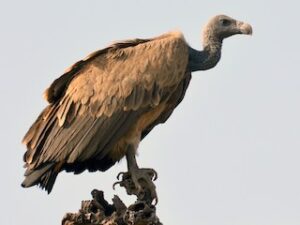GS 3 – Environment & Ecology

Overview
- Total Global Species: 23
- Species Found in India: 9
- Role: Scavengers, feeding on carrion, they prevent the spread of zoonotic diseases and maintain ecological balance.
- Nature: Highly social and often found in groups.
Conservation Status
| Species | IUCN Status |
| White-rumped Vulture | Critically Endangered |
| Slender-billed Vulture | Critically Endangered |
| Long-billed Vulture | Critically Endangered |
| Red-headed Vulture | Critically Endangered |
| Egyptian Vulture | Endangered |
| Himalayan Griffon | Near Threatened |
| Cinereous Vulture | Near Threatened |
| Bearded Vulture | Near Threatened |
| Griffon Vulture | Least Concern |
- CITES: Appendix II
- Wildlife Protection Act, 1972: Schedule I
Habitat & Distribution
- Preferred Habitats: Deserts, grasslands, savannas, and mountainous areas up to 3,000m.
- Near Water Sources: Commonly found near rivers or wetlands.
- Global Range: Absent in Australia and most oceanic islands.
Key Characteristics
- Physical Traits:
- Medium to large size, with a heavy body and shaggy feathers.
- Bald head and throat—aids in thermoregulation and hygiene.
- Broad wings adapted for high soaring.
- Behaviour:
- Soar using rising thermals, often circling at great heights.
- Feeding Habits:
- Primarily consume carrion, sometimes garbage or excrement.
- Rarely attack live prey, but may take helpless or injured animals.
Threats to Vultures
- Poisoning: From carcasses laced with veterinary drugs (e.g., Diclofenac).
- Lead Toxicity: Ingestion of lead fragments in carcasses.
- Electrocution & Collision: Power lines and wind turbines.
- Starvation: Habitat degradation and reduced food availability.
- Persecution: Superstitions and misunderstandings about their role.
Ecological Significance
- Prevent disease outbreaks: By consuming carcasses, vultures help stop the spread of rabies, anthrax, and other pathogens.
- Eco-cleaners: Play a key role in nutrient cycling in ecosystems.
Conservation Measures
Action Plan for Vulture Conservation (2020–2025)
Approved by National Board for Wildlife (NBWL)
Key Initiatives:
- Vulture Conservation and Breeding Centres:
- New centres in: Uttar Pradesh, Tripura, Maharashtra, Karnataka, Tamil Nadu.
- Vulture Safe Zones:
- At least one per state to protect remnant populations.
- Rescue Centres:
- Planned in: Pinjore (Haryana), Bhopal (MP), Guwahati (Assam), Hyderabad (Telangana).
- Toxic Drug Monitoring:
- Automatic ban system for drugs found to be harmful to vultures (in coordination with the Drugs Controller General of India).
- Vulture Census:
- Nationwide counting coordinated by:
- Forest Departments
- BNHS (Bombay Natural History Society)
- Research institutions
- NGOs and public volunteers
- Nationwide counting coordinated by:
- Threat Database:
- Comprehensive repository tracking:
- Electrocutions
- Collisions
- Unintentional poisonings
- Comprehensive repository tracking:




